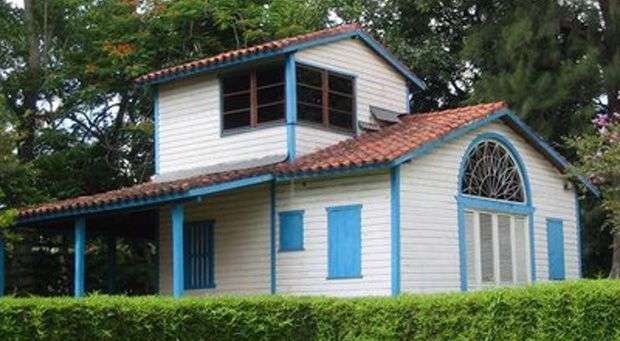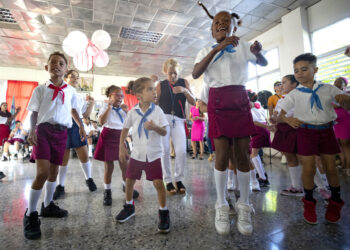It is small, white and blue, isolated from the world. A few square meters little house. It is whimsical with its fireplace anachronistic for the warm climate of the island, with its roof tiles and bizarre architecture, like railway stations in the northern United States and with certain colonial reminiscences.
The gabled roof, large windows and stained glass with a colorful arch are perhaps all the luxury. El Huron Azul is not flashy, nor surprises visitors. Halfway through a steep street stands a blue wooden fence and between the foliage you can hardly see the house built by the Cuban painter Carlos Enriquez.
Maybe it was not designed in his image and likeness, but it has his spirit. A clay flagstone path strewn with bottles leads to the entrance, an occurrence of the gardener to provide utility to the artist’s excesses.
His family wanted to confine him to the end of the world and he inherited from his father a lot in Párraga, forgotten and distant from the most populated places of Havana. But the house was never jail for Carlos; it became a refuge and center of creation.
They say one day he hung a ferret painted blue on the door and added a welcome sign like a cabal: Blue Dome. Thus the myth of a man who was legend among the vanguards art in the 1930s grew when the academicism stopped being fashionable and aesthetic rupture invaded the halls of art to prevail.
Among the larger spaces of the house is the portal that borders a portion of the ground floor. Once inside, four or five steps are enough to cross the room we could only formally call foyer or hall.
It is hard to imagine meeting in a Sunday afternoon, between Creole food odors, moist soil and mango leaves, friends of art and life: Félix Pita, Nicolás Guillén, Alejo Carpentier, Marcelo Pogolotti, René Portocarrero or Fidelio Ponce … we can only conceive them littered around the place, occupying all rooms. In the small room, to dominate the place with their impressive nudity, a group of frolic women in the mural over the fireplace, one of the few that remains of the painter. Water and fire in an harmonious whole.
A side door leads to the tiny room where the bathroom requested to be present in just one meter, there the big hips of his second wife, French Eva Frejaville, should know the meaning of economy of space. There was also a zinc door where Carlos painted her, where he immortalized the curves her naked body, now preserved in the Museum Cuban National Art.
At the end of the ground floor a kitchen dining room tries to be in place, a narrow rectangle illuminated by large semicircular stained glass that fills the walls of blues and greens and pinks. Not one of the wooden sheets is exclusive of the site; all construction has used parts, whatever his pocket could afford.
Upstairs there is only one room, like a watchman, whose large glass windows allow to dominate the surrounding full of palms, constant element in the work of Carlos with his unforgettable transparencies and curves.

The rungs of the ladder leading to that studio room still retain some traces of white, wrapped in mysticism and fantasy of a neighborhood deeply devoted to the Yoruba religion, and many believe that the ghost of the painter inhabits the house and runs quietly around it.
Here, Carlos wrote his novels “Tilin Garcia” from the archetypal villain of Cuban fields, “The Return of Chencho” inspired by the atmosphere of an abandoned house in Parraga, and “The Guaicanama fair “, not very well received by the public and critics. In 1980, the Ministry of Culture decided that all Cuban municipalities should have their own museum. The capital’s Arroyo Naranjo, peripheral and suburban, bland little history and artistic, economic or social life, of course, had none.
But almost all Párraga knew the history of that house where a ‘half-crazy man who painted naked women “dwelt. The collective memory saved the trouble for the distressed officials who believed the house where Carlos Enriquez lived the last 18 years of his life was lost.
The place was very run down, but none of its diverse inhabitants dared to desecrate the mural: the good works often inspire respect and devotion. The original spaces also remained intact and after restoration work, opened to the public as a museum on May 21, 1987.
(by Isabel Menéndez)









